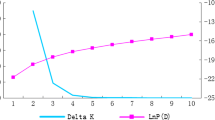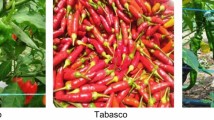Abstract
Availability of standardized morphological and molecular characterization data is essential for the efficient development of breeding programmes in emerging crops. Pepino (Solanum muricatum) is an increasingly important vegetatively propagated vegetable crop for which concurrent data on morphological descriptors and molecular markers are not available. We evaluated 58 morphological traits, using a collection of 14 accessions of pepinos (including local Andean varieties and modern cultivars) and 8 of wild relatives, using the IPGRI and COMAV descriptors lists coupled with 20 EST-SSRs from tomato. High morphological diversity was found in both cultivated and wild accessions; all morphological traits except three were variable. Cultivated pepino and wild relatives were significantly different for 26 traits. Also, local varieties and modern cultivars of pepino were different from each other for 13 morphological traits and were clearly separated in a principal components analysis. Fourteen of the 20 tomato EST-SSRs were polymorphic, with an average number of alleles per locus of 4.07 and a polymorphic information content value of 0.4132. This revealed a high degree of transferability from tomato to pepino and wide molecular diversity in the collection. Cultivated materials manifest high levels of observed heterozygosity, suggesting that it is related to heterosis for yield associated with heterozygosis. SSR data clearly differentiated cultivated and wild materials. Furthermore, for pepinos, the modern varieties were genetically much less diverse than the traditional local varieties. However, both groups of cultivated material expressed a low degree of genetic differentiation. A strong correlation (r = 0.673) between morphological and molecular distances was found. Our results provide foundational information for programmes of germplasm conservation, and that can be used to enhance breeding for this emerging crop.




Similar content being viewed by others
References
Abouelnasr H, Li YY, Zhang ZY, Liu JY, Li SF, Li W, Yu JL, McBeath JH, Han CG (2014) First report of Potato virus H on Solanum muricatum in China. Plant Dis 98:1016
Anderson GJ (1975) The variation and evolution of selected species of Solanum section Basarthrum. Brittonia 27:209–222
Anderson GJ (1979) Systematic and evolutionary consideration of Solanum section Basarthrum. In: Hawkes JG, Lester RN, Skelding AD (eds) The biology and taxonomy of the Solanaceae. Royal Botanic Gardens Kew and Linnean Society, London, pp 549–562
Anderson GJ, Symon DE (1988) Insect foragers on Solanum in Australia. Ann Missouri Bot Garden 75:842–852
Anderson GJ, Jansen RK, Kim Y (1996) The origin and relationships of the “pepino”, Solanum muricatum (Solanaceae): DNA restriction fragment evidence. Econ Bot 50:369–380
Anderson GJ, Martine CT, Prohens J, Nuez F (2006) Solanum perlongystilum and S. catilliflorum, new endemic Peruvian species of Solanum, section Basarthrum, are close relatives of the domesticated pepino, S. muricatum). Novon 16:161–167
Blanca JM, Prohens J, Anderson GJ, Cañizares J, Zuriaga E, Nuez F (2007) AFLP and DNA sequence variation in an Andean domesticate, pepino (Solanum muricatum, Solanaceae): implications for evolution and domestication. Am J Bot 94:1219–1229
Botstein D, White RL, Skolnick M, Davis RW (1980) Construction of a genetic map in man using restriction fragment length polymorphisms. Am J Human Genet 32:314–331
Cavusoglu C, Sululoglu M (2013) In vitro propagation and acclimatization of pepino (Solanum muricatum). J Food Agric Environ 11(1):410–415
Cocaliadis MF, Fernández-Muñoz R, Pons C, Orzaez D, Granell A (2014) Increasing tomato fruit qualityby enhancing fruit chloroplast function. A double edged sword? J Expt Bot 65:4589–4598
Cooper HD, Spillane C, Hodgkin T (2001) Broadening the genetic base of crop production. CABI, Wallingford
Davis DR (2009) Declining fruit and vegetable nutrient composition: What is the evidence? HortScience 44:15–19
Dawes SN, Pringle GJ (1983) Subtropical fruits from South and Central America. In: Wratt G, Smith HC (eds) Plant breeding in New Zealand. Butterworths, Wellington, pp 33–35
Doyle JJ, Doyle JL (1987) A rapid DNA isolation procedure for small quantities of fresh leaf tissue. Phytochem Bull 19:11–15
FAO (2010) The second report on the state of the world’s plant genetic resources for food and agriculture. Food and Agriculture Organization, Rome
Frary A, Xu Y, Liu J, Mitchell S, Tedeschi E, Tanksley S (2005) Development of a set of PCR-based anchor markers encompassing the tomato genome and evaluation of their usefulness for genetics and breeding experiments. Theor Appl Genet 111:291–312
Ghislain M, Núñez J, Herrera MR, Pignataro J, Guzman F, Bonierbale M, Spooner DM (2009) Robust and highly informative microsatellite-based genetic identity kit for potato. Mol Breed 23:377–388
Hsu CC, Guo YR, Wang ZH, Yin MC (2011) Protective effects of an aqueous extract from pepino (Solanum muricatum Ait.) in diabetic mice. J Sci Food Agric 91:1517–1522
IPGRI, COMAV (2004) Descriptors for pepino (Solanum muricatum). International Plant Genetic Resources Institute, Rome
Kalia RK, Mai MK, Kalia S, Singh R, Dhawan AK (2011) Microsatellite markers: an overview of the recent progress in plants. Euphytica 177:309–334
Khoury C, Laliberté B, Guarino L (2010) Trends in ex situ conservation of plant genetic resources: a review of global crop and regional conservation strategies. Genet Res Crop Evol 57:625–639
Levy D, Kedar N, Levy N (2006) Pepino (Solanum muricatum Aiton): Breeding in Israel for better taste and aroma. Israel J Plant Sci 54:205–213
Lin T, Zhu G, Zhang J, Xu X, Yu Q, Zheng Z, Zhang Z, Lun Y, Li S, Wang X, Huang Z, Li J, Zhang C, Wang T, Zhang Y, Wang A, Zhang Y, Lin K, Li C, Xiong G, Xue Y, Mazzucato A, Causse M, Fei Z, Giovannoni JJ, Chetelat RT, Zamir D, Städler T, Li J, Ye Z, Du Y, Huang S (2014) Genomic analyses provide insight into the history of tomato breeding. Nature Genet 46:1220–1226
Mantel NA (1967) The detection of disease clustering and a generalized regression approach. Cancer Res 27:209–220
Mayes S, Massawe FJ, Alderson PG, Roberts JA, Azam-Ali SN, Hermann M (2012) The potential for underutilized crops to improve security of food production. J Expt Bot 63:1075–1079
Meudt HM, Clarke AC (2007) Almost forgotten or latest practice? AFLP applications, analyses and advances. Trends Plant Sci 12:106–117
Mione T, Anderson GJ (1992) Pollen-ovule ratios and breeding system evolution in Solanum section Basarthrum (Solanaceae). Am J Bot 79:279–287
Muñoz C, Pertuzé R, Balzarini M, Bruno C, Salvatierra A (2014) Genetic variability in Chilean pepino (Solanum muricatum Aiton) fruit. Chil J Agric Res 74:143–147
Nei M (1973) Analysis of genetic diversity in subdivided populations. Proc Natl Acad Sci USA 70:3321–3323
Peters SA, Bargsten JW, Szinay D, van de Belt J, Visser RGF, Bai YL, de Jong H (2012) Structural homology in the Solanaceae: analysis of genomic regions in support of synteny studies in tomato, potato and pepper. Plant J 71:602–614
Prohens J, Ruiz JJ, Nuez F (1996) The pepino (Solanum muricatum, Solanaceae): a “new” crop with a history. Ec Bot 50:355–368
Prohens J, Ruiz JJ, Nuez F (1998) The inheritance of parthenocarpy and associated traits in the pepino. J Amer Soc Hort Sci 123:376–380
Prohens J, Leiva-Brondo M, Rodríguez-Burruezo A, Nuez F (2002) ‘Puzol’: a facultively parthenocarpic hybrid of pepino (Solanum muricatum). HortScience 37:418–419
Prohens J, Sánchez MC, Rodríguez-Burruezo A, Cámara M, Torija E, Nuez F (2005) Morphological and physico-chemical characteristics of fruits of pepino (Solanum muricatum), wild relatives (S. caripense and S. tabanoense) and interspecific hybrids. Implications in pepino breeding. Eur J Hort Sci 70:224–230
Rao VR, Hodgkin T (2002) Genetic diversity and conservation and utilization of plant genetic resources. Plant Cell, Tissue Organ Cult 68:1–19
Rodríguez-Burruezo A, Prohens J, Nuez F (2003a) Wild relatives can contribute to the improvement of fruit quality in pepino (Solanum muricatum). Euphytica 129:311–318
Rodríguez-Burruezo A, Prohens J, Nuez F (2003b) Performance of hybrid segregating populations of pepino (Solanum muricatum) and its relation to genetic distance among parents. J Hort Sci Biotechnol 78:911–918
Rodríguez-Burruezo A, Prohens J, Leiva-Brondo M, Nuez F (2004a) ‘Turia’ pepino. Can J Plant Sci 84:603–606
Rodríguez-Burruezo A, Prohens J, Nuez F (2004b) ‘Valencia’: a new pepino (Solanum muricatum) cultivar with improved fruit quality. HortScience 39:1500–1502
Rodríguez-Burruezo A, Prohens J, Fita AM (2011) Breeding strategies for improving the performance and fruit quality of the pepino (Solanum muricatum): a model for the enhancement of underutilized exotic fruits. Food Res Intl 44:1927–1935
Ruiz JJ, Prohens J, Nuez F (1997) ‘Sweet Round’ and ‘Sweet Long’: Two pepino cultivars for Mediterranean climates. HortScience 32:751–752
Sakomoto K, Taguchi T (1991) Regeneration of intergeneric somatic hybrid plants between Lycopersicon esculentum and Solanum muricatum. Theor Appl Genet 81:509–513
Särkinen T, Bohs L, Olmstead RG, Knapp S (2013) A phylogenetic framework for evolutionary study of the nightshades (Solanaceae): a dated 1000-tip tree. BMC Evol Biol 13:214
Schuelke M (2000) An economic method for the fluorescent labeling of PCR fragments. Nature Biotechnol 18:233–234
Simms C (1996) Catalogue of plants. Clive Simms, Lincolnshire
Smouse PE, Peakall R (1999) Spatial autocorrelation analysis of individual multiallele and multilocus genetic structure. Heredity 82:561–573
Spooner DM, Anderson GJ, Jansen RK (1993) Chloroplast DNA evidence for the interrelationships of tomatoes, potatoes, and pepinos (Solanaceae). Amer J Bot 80:676–688
Sudha G, Priya MS, Shree RBI, Vadivukkarasi S (2012) Antioxidant activity of ripe and unripe pepino fruit (Solanum muricatum Aiton). J Food Sci 77:C1131–C1135
Suresh BV, Roy R, Sahu K, Misra G, Chattopadhyay D (2014) Tomato genomic resources database: an integrated repository of useful tomato genomic information for basic and applied research. PLoS One 9:e86387
Vilanova S, Hurtado M, Cardona A, Plazas M, Gramazio P, Herraiz FJ, Andújar I, Prohens J (2014) Genetic diversity and relationships in local varieties of eggplant from different cultivar groups as assessed by genomic SSR markers. Not Bot Horti Agrobo 42:59–65
Yalçin H (2010) Effect of ripening period on composition of pepino (Solanum muricatum) fruit grown in Turkey. Afr J Biotechnol 9:3901–3903
Yildiz M, Akgul N, Sensoy S (2014) Morphological and molecular characterization of Turkish landraces of Cucumis melo L. Not Bot Horti Agrobo 42:51–58
Author information
Authors and Affiliations
Corresponding author
Rights and permissions
About this article
Cite this article
Herraiz, F.J., Vilanova, S., Andújar, I. et al. Morphological and molecular characterization of local varieties, modern cultivars and wild relatives of an emerging vegetable crop, the pepino (Solanum muricatum), provides insight into its diversity, relationships and breeding history. Euphytica 206, 301–318 (2015). https://doi.org/10.1007/s10681-015-1454-8
Received:
Accepted:
Published:
Issue Date:
DOI: https://doi.org/10.1007/s10681-015-1454-8




